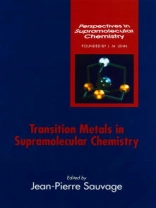Perspectives in Supramolecular Chemistry will relate recent developments and new exciting approaches in supramolecular chemistry. In supramolecular chemistry, our aim is to understand molecular chemistry beyond the covalent bond – the series will concentrate on goal-orientated supramolecular chemistry. Perspectives in Supramolecular Chemistry will reflect research which develops supramolecular structures with specific new properties, such as recognition, transport and simulation of biosystems or new materials. The series will cover all areas from theoretical and modelling aspects through organic and inorganic chemistry and biochemistry to materials, solid-state and polymer sciences reflecting the many and varied applications of supramolecular structures in modern chemistry. Transition Metals in Supramolecular Chemistry Edited by Jean-Pierre Sauvage, Universite Louis Pasteur, Strasbourg, France The chemistry of weak forces and non-covalent interactions as pioneered by Pedersen, Lehn and Cram is considered to be the origin of modern supramolecular chemistry. 30 years ago transition metals and their complexes were not regarded as important to this science. Transition Metals in Supramolecular Chemistry clearly demonstrates that today, transition metal complexes are routinely used to build large multicomponent architectures which display new and exciting applications including molecular switches, liquid crystals, and molecular magnets. Contents
* Ligand and Metal Control of Self-Assembly in Supramolecular Chemistry
* Bistability in Iron (II) Spin-Crossover Systems: A Supramolecular Function
* Luminescent Sensors with and for Transition Metals
* The Chirality of Polynuclear Transition Metal Complexes
* Design and Serendipity in the Synthesis of Polynuclear Compounds of the 3d-metals
* Rotaxanes: From Random to Transition Metal-Templated Threading of Rings at the Molecular Level
* Metallomesogens – Supramolecular Organisation of Metal Complexes in Fluid Phases
* Self-Assembly of Interlocked Structures with Cucurbituril Metal Ions and Metal Complexes
Reflecting contemporary science, Transition Metals in Supramolecular Chemistry will inspire scientists and students interested in coordination chemistry, magnetochemistry, molecular sensors and switches, liquid crystals and artificial systems.
Table of Content
Contributors vii
Preface ix
1 Ligand and Metal Control of Self-Assembly in Supramolecular Chemistry
Rolf W. Saalfrank and Bernhard Demleitner 1
2 Bistability in Iron (II) Spin-Crossover Systems: A Supramolecular Function
José Antonio Real 53
3 Fluorescent Sensors for and with Transition Metals
Luigi Fabbrizzi, Maurizio Licchelli, Piersandro Pallavicini, Luisa Parodi and Angelo Taglietti 93
4 The Chirality of Polynuclear Transition Metal Complexes
Christophe Provent and Alan F. Williams 135
5 Design and Serendipity in the Synthesis of Polymetallic Complexes of the 3d-Metals
Richard E. P. Winpenny 193
6 Rotaxanes: From Random to Transition Metal-Templated Threading of Rings at the Molecular Level
Jean-Claude Chambron 225
7 Metallomesogens–Supramolecular Organization of Metal Complexes in Fluid Phases
Simon Collinson and Duncan W. Bruce 285
8 Self-Assembly of Interlocked Structures with Cucurbituril, Metal Ions and Metal Complexes
Kimoon Kim 371
Cumulative Author Index 403
Cumulative Title Index 407
Index 409
About the author
Jean-Pierre Sauvage performed his studies at the Ecole Nationale Superieure de Chimie de Strasbourg where he obtained his Ph D under the supervision of Prof. J.M. Lehn in 1971. After post-doctoral research with Prof. M.L.H. Green in Oxford, UK, he went back to Strasbourg as a CNRS researcher. He founded his research group in 1980, became University Professor in 1981 and also CNRS Director of Research in 1988. Professor Sauvage is a member of the French Academy of Science, Professor emeritus of the University of Strasbourg and currently a Distinguished Visiting Scholar at Northwestern University. His research interest spans from artificial photosynthesis and electron transfer to porphyrin chemistry, molecular topology, and transition metal-based molecular machines.












